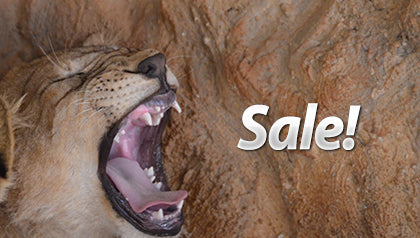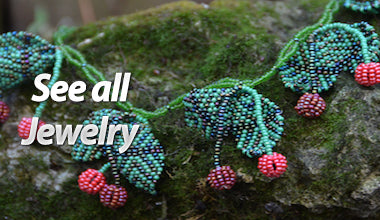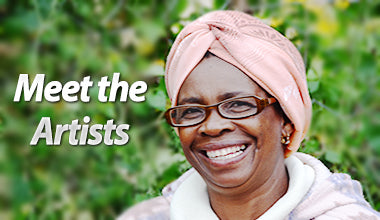FAQs
Who makes the products for LivAfrika?
All the products are lovingly made by our network of skilled artisans in Africa. We have developed long-term relationships with various cooperatives that specialize in a particular medium, such as paper, beads, bone, telephone wire, sisal , etc. All raw materials are acquired legally, ethically and with ecological sustainability as a priority.
Do you visit the artisans on a regular basis?
Yes we visit the artisans at least once a year if not twice. We visit them in their homes and also in the workshops at the cooperative in Africa. It is this close personal working relationship that allows us to exchange information, share ideas and be sure that the artisans well being is improving.
Who designs the products for LivAfrika?
All artistry is uniquely African and is based on the various culture and tradition of the individual artist. LivAfrika works directly with African artisans to showcase their exquisite and unique designs to the world.
How much of the proceeds go back to the artisans and their communities? 100%
What is Fair Trade?
The Fair Trade movement can be traced back to 1946 when Edna Ruth Byler, a volunteer for Mennonite Central Committee (MCC), visited an MCC sewing class in Puerto Rico. She soon realized that the women creating the beautiful lace, though immensely talented, lived in terrible poverty. In an attempt to help, she set out to carry their work back to the United States to sell them and then return the money back to the groups directly. Her work grew into Ten Thousand Villages, which opened its first fair trade shop in 1958 and is now the largest fair trade retailer in North America. In 1949, Sales Exchange for Refugee Rehabilitation and Vocation (SERRV International) began helping recovering World War II refugees in Europe. Today, they support artisans in more than 35 countries.
In the late 1970s, US- and Canadian-based entrepreneurs devoted to helping producers market their crafts began to meet regularly, exchange ideas, and network. Out of this process developed the Fair Trade Federation, which formally incorporated in 1994. In 1989, the World Fair Trade Organization (formerly IFAT) was founded as a global network of committed fair trade organizations, seeking improvement in the livelihoods of marginalized people via trade, and to provide a forum for the exchange of information and ideas.
In 1988, as world coffee prices began to sharply decline, a Dutch NGO, Solidaridad, and a farmer organization, UCIRI, created the first fair trade certification initiative. Named after a best-selling 19th century book, the Max Havelaar label initially applied only to coffee in the Netherlands, but more of Europe soon witnessed the growth of similar labeling initiatives within just a few years. In 1997, these organizations created Fairtrade Labelling Organizations International (FLO), an umbrella organization which sets the fair trade certification standards and supports, inspects, and certifies disadvantaged farmers. In 1997, FLO affiliate TransFair Canada opened, followed soon after by TransFair USA, now known as Fair Trade USA, in 1999.
Fair trade sales and consumer awareness have seen tremendous growth since 2000 while the range of fair trade products has also expanded. From starting with lace and home décor, handmade items now include clothing, sports equipment, toys, jewelry, and other items. From its initial focus on coffee, fair trade product certification now also focuses on tea, chocolate, sugar, vanilla, fruit, wine, jewelry, furniture, and much more. The first World Fair Trade Day was celebrated in 2002 to heighten consumer awareness and to strengthen connections among fair traders and interested citizens around the globe. In 2006, IFAT reported that total fair trade sales topped $2.6 billion.
Fair trade continues to expand across the globe due to the efforts of consumers, entrepreneurs, non-governmental organizations, and other communities to embrace a movement that offers real solutions to poverty, inequality, and a way towards social justice.
Do Fair Trade goods cost more than non-Fair Trade goods?
No. Fair Trade crafts generally do not cost more than other goods because the middle players in the supply chain are removed, thus decreasing the mark up costs. Each additional person in the supply chain adds on to the cost of the product, as that person expects a profit. Since there is more of a direct link from consumer to producer in a Fair Trade scenario, costs are kept comparable to non-Fair Trade goods, and more of the profit goes to the producer rather than to many different people in the supply chain.
How is Fair Trade making a difference if the sales volume is so low compared to non-Fair Trade sales?
First, Fair Trade sales volume is not low: retail sales of Fair Trade items passed $1.1 billion in the U.S. in 2009. That has generated additional income paid to producers, beyond normal market rates, of $48 million. Further, for a Peruvian weaving cooperative making only a few hundred dollars a year, a $1,000 craft sale to a Fair Trade Organization is a significant increase in income. In some parts of the world, Fair Trade earnings are turned over to the community to improve quality of life. The money may fund a potable water system or provide health education or bring an adult literacy program to the community. Keep in mind, there is a much more direct link from consumer to producer in Fair Trade, and so the producers benefit that much more from each incremental increase in revenue.
What are cooperative workplaces, and why are they important to Fair Trade?
Cooperatives and producer associations provide a healthy alternative to large-scale manufacturing and sweatshop conditions, where unprotected workers earn below minimum wage and most of the profits flow to foreign investors and local elites who have little interest in ensuring the long term health of the communities in which they work. Fair Trade Organizations work primarily with small businesses, worker-owned and democratically run cooperatives and associations which bring significant benefits to workers and their communities. By banding together, workers are able to access credit, reduce raw material costs and establish higher and more just prices for their products. Workers earn a greater return on their labor, and profits are distributed more equitably and often reinvested in community projects such as health clinics, child care, education, and literacy training. Workers learn important leadership and organizing skills, enabling self-reliant grassroots-driven development.
Do Fair Trade Organizations offer financial support to producers?
Yes. Small-scale farmers and artisans in the developing world lack access to affordable financing, impeding their profitability. Fair Trade Organizations that buy products directly from producers often provide financial assistance either through direct loans, pre-payment, or by linking producers with sources of financing. Unlike many commercial importers who often wait 60-90 days before paying producers, many Fair Trade Organizations ensure pre-payment so that producers have sufficient funds to cover raw materials and basic needs during production.
Do Fair Trade Organizations offer technical support to producers?
Yes. Fair Trade Organizations provide crucial technical assistance and support such as market information, organizational development and training in financial management. Unlike conventional importers, Fair Trade Organizations establish long term relationships with their producers and help them adapt production to changing trends, which ultimately helps the producer communities to become more economically sustainable.
How does Fair Trade help artisan communities?
In artisan communities, schools are built, wells are constructed, children attend school, essential medical care is provided, and income is generated by fair trade sales. In addition, cultural techniques are revived; women become valued members of their societies; alternative production methods preserve bio diversity; small and medium sized enterprises in the developing world increase their capacity. These are a few of the many benefits to artisan communities in the developing world from Fair Trade.
How do LivAfrika Volunteer Sales work?
You or your organization can host a sale of LivAfrika items in your community. These sales are usually one-time events that are fun to hold on their own or in combination with another event. By submitting two forms, placing an order, and selling the products, you are doing the invaluable hands-on work to help create employment for disadvantaged women and artisans all over Africa and South Africa. There are a few options for you to choose from, including a risk-free consignment option where you choose from a selection of around 100 products and a wholesale option featuring many more products and a larger discount.
Can I have someone come and talk to us about Helping Women, Transforming Lives?
Yes. I am available to personally come and talk to your group and discuss how my company is making a difference in and around Africa and how you can help continue our progress. See the Contact Us section of our site and let’s talk.
Fair Trade FAQs
Our mission at LivAfrika is "Empowering Women, Transforming Lives". This is accomplished by a twofold approach. We start by giving the artist exposure to the international market for her exquisite African home decor, jewelry & gifts. In addition, all of the proceeds are reinvested back into the artisan community to uplift these disadvantaged women and children and transform their lives. Therefore their individual income is improved through increased demand for the product and through the reinvestment of profits into community projects.



